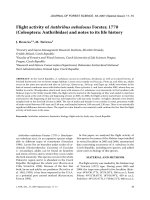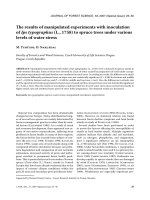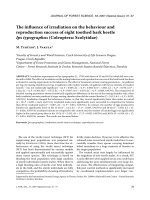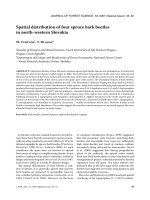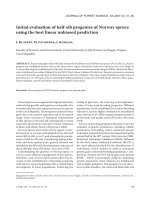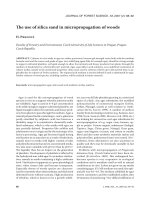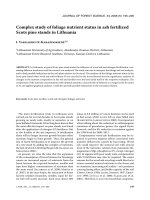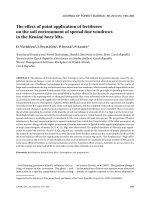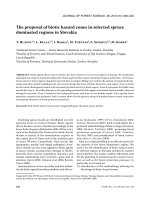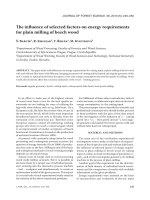Báo cáo lâm nghiệp: "Effect of Melampsora larici-populina on growth and biomass yield of eight clones of Populus nigra" ppsx
Bạn đang xem bản rút gọn của tài liệu. Xem và tải ngay bản đầy đủ của tài liệu tại đây (419.61 KB, 9 trang )
J. FOR. SCI., 57, 2011 (2): 41–49 41
JOURNAL OF FOREST SCIENCE, 57, 2011 (2): 41–49
Eff ect of Melampsora larici-populina on growth
andbiomass yield of eight clones of Populus nigra
V. B, K. Č, P. P, K. K
Silva Tarouca Research Institute for Landscape and Ornamental Gardening, Průhonice,
CzechRepublic
ABSTRACT: This study evaluates the effect of the identified pathogenic races E1, E2 and E3 of the leaf rust Melamp-
sora larici-populina on some growth traits and biomass yield in the species Populus nigra. A field trial was conducted
with 8 clones of P. nigra using fungicide-sprayed and unsprayed treatments in 3 replications of 4 plants. In the course
of three years the occurrence of the rust was evaluated on a six-point scale. The plant height and stem diameter were
measured during the trial. In the last year the plants were harvested and the dry weight was determined. In the un-
treated plants a significant negative correlation was found between the intensity of rust occurrence and the values of
stem diameter and dry matter yield (P < 0.05). A decline in dry matter yield caused by the rust was low (below 9%) or
zero in a half of the clones while it ranged between 19% and 28% in the other half of clones. In some clones the yield
decline was relatively low although the expression of rust symptoms was rather high which could be attributed to a
tolerance to the given pathogen.
Keywords: biomass yield; Melampsora larici-populina Kleb.; poplar; resistance
Supported by the Ministry of Education, Youth and Sports of the Czech Republic, Project No. 2B06132.
e genus Populus L. comprises fast-growing
woody plants suitable to be grown under short-
rotation systems for the production of biomass
as a renewable energy source. For these purposes
clones, interspecifi c hybrids, originating from in-
trasectional as well as intersectional crosses are
almost exclusively used. It should be noted that up
to 60% of clones have P. nigra (Directory of Poplar,
FAO 2000) as one of the parental components.
In recent years experiments have been conducted
to test the yield potential and growth of the black
poplar in coppice forests with relatively promis-
ing results (L et al. 2005; B et
al. 2007; A A et al. 2008). One of the reasons
for the study of P. nigra was to identify clones that
could replace interspecifi c hybrids in areas where
the growing of allochthonous species is banned by
law (e.g. in national parks and adjacent territories)
and to replace them with an autochthonous spe-
cies (B et al. 2002). In the above-mentioned
experiments, and in diff erent climatic conditions,
clones of the species P. nigra achieved relatively
positive results in terms of biomass yield compared
to hybrid clones.
In our evaluation of black poplars, the impor-
tance of leaf rust pathogens of the genus Melam-
psora was also kept in mind. ree Melampsora
species are pathogenic on cultivated poplars in
Europe: M. larici-populina Kleb., M. allii-populina
Kleb. and M. medusae üm. e latter does not
occur in the Czech Republic but can be found in
southwestern France, Spain and Portugal (P
1991). M. allii-populina is rather scarce in Central
Europe (M 1977; K, M 2004)
while M. larici-populina is a dominant species of
the genus Melampsora in poplars of Central Eu-
42 J. FOR. SCI., 57, 2011 (2): 41–49
rope. At present, fi ve races with eight virulences
and potentially 256 pathotypes are known within
M. larici-populina (P, F 2005). However,
the intraspecifi c structure of M. larici-populina
occurring in the Czech Republic has been studied
only sporadically up to now (B et al. 2008).
A negative impact of the leaf rust M. medusae on
several cultivars of hybrid poplars in experiments
conducted by W and S (1981) was re-
fl ected in a decline of dry weight wood yield by up
to 57%. e leaf rust M. larici-populina is also con-
sidered a signifi cant pathogen that may cause great
damage to poplar stands. L et al. (1998)
reported that in France in the hybrid clone ‘Lu-
isa Avanzo’ this pathogen caused economic losses
amounting to 50% of annual increment in three- to
six-years old stands as a result of reduced photo-
synthetic effi ciency, premature defoliation and in-
creased susceptibility to other pests and diseases.
On the widely planted cultivar ‘Beaupré’, growth
restriction due to rust was estimated to be 20% to
30% of the biomass in the fi rst year of infection and
up to 50% to 60% in the following years (G
at al. 2003). L et al. (2005) reported the
mortality of plants due to rust as the cause of a de-
cline in biomass yield in young stands of hybrid
poplars.
e above-mentioned examples raise the ques-
tion how dangerous the leaf rust M. larici-populi-
na is to black poplar, in which a diff erent type of
resistance other than that in hybrid poplars is ex-
pected. As documented by literary data, in some
present poplar hybrids rust resistance is qualitative
(L et al. 1994; D, B 2007),
while in black poplar it is probably quantitative
(L et al. 1999).
As this short overview shows, published papers
have sporadically reported on the infl uence of the
rust M. larici-populina on dry matter yield in the
genus Populus. Yield decline was determined only
for few cultivars of hybrid poplar but no consider-
ation has been given to the species P. nigra.
MATERIAL AND METHODS
Field trial
Material
Eight clones of P. nigra with a diff erent level of re-
sistance to Melampsora larici-populina Kleb. origi-
nated from own breeding programme of P. nigra.
Parental trees are plus trees that were found in a
natural environment (Table 1). e parental com-
ponents were composed in such a way that the
parents would come from diff erent climatic and
geographic conditions. eir genetic diversity was
confi rmed by DNA analysis (microsatellites).
Methods
e trial was conceived in spring 2005 at Michov-
ky locality in the area of the Silva Tarouca Research
Institute in Průhonice. Average temperatures and
precipitation amounts for the experimental period
2005–2007 are shown in Table 2. e trial was es-
tablished with one-year plants grown from cut-
tings. Eight clones in two treatments and in three
replications by four plants were set out at a spac-
ing of 2.20 × 0.45 m. One treatment was fungicide-
sprayed (s) and the other was unsprayed (u). A
guard row was planted between the sprayed and
unsprayed treatment. In 2005 the fungicide Acanto
(Picoxystrobin) was applied at a concentration of
0.25%. Because its effi cacy was low, it was replaced
by a combination of the fungicides Amistar 0.25%
+ Impact 0.25% (Azoxystrobin + Flutriafol) in 2006
and 2007. Sprayings were always conducted before
the fi rst rust symptoms appeared (the end of June)
and afterwards, before the end of residual eff ect
(mid-July and beginning of August).
Evaluation
e trait of resistance to Melampsora larici-
populina was evaluated in fi eld conditions using a
6-point scale: 0 – no signs of rust infection on leaves;
1 – small patches covered by uredia on a half of the
Table 1. Localization of parental trees from which the tested clones of black poplar originate
Tested clones
♀ ♂
altitude (m a.s.l.) latitude N longitude E altitude (m a.s.l.) latitude N longitude E
7; 9; 107; 110; 113 420 49°14' 13°31' 242 49°36' 17°20'
37 550 49°13' 13°40' 145 50°32' 14°08'
49 295 49°39' 18°22' ± 200* – –
152 635 50°09' 16°08' 160 50°20' 14°29'
*pollinated by a pollen mixture
J. FOR. SCI., 57, 2011 (2): 41–49 43
leaves; 2 – small patches covered by uredia on most
leaves; 3 – larger patches of rust up to continu-
ous coverage on all leaves; 4 – rust coverage of the
whole leaves, incipient leaf necrosis; 5 – all leaves
necrotised or shed. e overall condition of plants
was also considered during the evaluation of uredial
counts on leaves. e evaluation was done on sev-
eral dates (from July to October). Mid-August was
the best time to distinguish the resistance of clones
because diff erences among the clones were small on
earlier dates due to the lower environmental abun-
dance of the pathogen. On later dates, toward the
end of the growing season, there was an extreme
increase in the inoculum amount in the environ-
ment and a signifi cant increase in infection pressure,
which caused a partial blurring of diff erences. is
is the reason why the clones were compared around
that date with regard to the pathogen development.
e point values used for data processing are aver-
ages of the evaluation of three times four plants.
e growth traits of stem diameter at a height
of 0.5 m to the nearest 1 mm and plant height to
the nearest 0.1 m were measured at the end of the
growing season. In 2007, the growth traits were
measured at two-week intervals. e last measure-
ment that was done at the end of vegetation was
used for calculations. Biomass was harvested at
the beginning of January 2008. All plants from the
particular parcels were weighed together and the
dry matter was determined from samples of fresh
biomass dried to a constant weight at 105°C as de-
scribed by B et al. (2002).
Statistical analyses
Statistical evaluation was done using the statisti-
cal package Statistica 7.1 (StatSoft Inc., Tulsa, OK).
e analysis of the eff ect of independent factors
(clone, treatment, repetition) on dependent vari-
ables was carried out by analysis of variance, and
the post-hoc comparisons were made by Duncan’s
test. e assumptions of homogeneity and normal-
ity were fulfi lled. e diff erences in rust severity
among clones were tested using the Kruskal-Wal-
lis test. e diff erences in growth traits between
sprayed and unsprayed treatments were tested by
paired t-test. Correlations were tested using Spear-
man’s coeffi cient of rank correlation (r
s
). is test
was used to evaluate the stability of the degree of
infection within the particular clones of black pop-
lar in the years of observation, the relationship be-
tween the severity of clone infection by rust and
the value of the growth traits and dry weight.
Laboratory test for race
spectrum determination
In August 2005 the intraspecifi c structure of
Melampsora larici-populina was preliminarily in-
vestigated by artifi cially infecting a set of test clones
– ‘Robusta’, ‘Ogy’ (Populus × canadensis), ‘Unal’,
‘Hoogvorst’, ‘Beaupré’ (Populus × interamericana)
and ‘Aurora’ (P. candicans Ait.) (P, F 1997,
2005) with acquired fungus isolates. Leaves with few
rust uredia were collected to minimize the chance
of cross-contamination during the acquisition of
isolates. e spore suspension was acquired using
a micropipette to apply 20 µl of sterile water agar
(0.1 g·l
–1
) to the particular uredia. is was then pi-
petted out and applied as small droplets to the set of
leaf discs of test clones. e inoculated discs were
cultivated in sterilized Petri dishes (20cm in diam-
eter) on fi lter paper soaked with deionized water at
20°C. Artifi cial radiation simulated daylight wave-
length and intensity, and the discs were maintained
under a 16-h light period each day. Cultivation to
fully developed uredia on leaf discs lasted two weeks.
RESULTS
Field trial
Occurrence of Melampsora larici-populina
e fi rst incidence of M. larici-populina was ob-
served in mid-July in the unsprayed treatment
whereas the fungicide-sprayed treatment was nearly
without leaf rust occurrence throughout the veg-
etation period (Table 3). Only in the fi rst year (2005)
was a lower incidence (1.2–1.9) observed. After the
exchange of pesticide (2006 and 2007), the treated
plants were without symptoms at the end of August.
e rust occurrence was low with average values from
0.6 to 1.4 points at the end of the vegetation period.
Diff erences in the intensity of rust infection
among the clones in the unsprayed treatment were
Table 2. Temperatures and precipitation amounts during
the trial conducted in Michovky locality
2005 2006 2007
Average temperature (°C)
Year average/sum 8.8 9.2 10.2
Vegetation period (IV–IX) 15.3 15.8 16.0
Amount of precipitation (mm)
Year average/sum 481.6 474.5 517.4
Vegetation period (IV–IX) 314.2 293.4 320.9
44 J. FOR. SCI., 57, 2011 (2): 41–49
tested in all observed years with the results always
being quite similar. e result of the Kruskal-Wallis
test was always highly signifi cant (P << 0.001), i.e.
the studied clones were signifi cantly diff erent in
the intensity of rust infection. A post hoc compari-
son showed that clones 107 and 152 were always
infected to a signifi cantly (P < 0.05) lesser extent
than some other clones (mainly 9 and 49). Rust
symptoms of the lowest intensity (2.5–2.8) were
observed in clone 152. e highest intensity of
infection (3.6–4) was determined in clone 9. is
clone was signifi cantly diff erent (P < 0.05) in infec-
tion from clones 7, 107, 110, 152.
e stability of the intensity of infection of black
poplar clones by the rust (the rank of clones ac-
cording to the intensity of infection) between the
particular years was evaluated using Spearman’s
coeffi cient of rank correlation. e results demon-
strated that the rank of clones according to the in-
tensity of rust infection was signifi cantly correlated
in all years. e correlation coeffi cient of infection
occurrence in 2005 and 2006 was 0.87 (P < 0.01), in
2005 and 2007 it was 0.76 (P < 0.05), and in 2006
and 2007 its value amounted to 0.92 (P < 0.01). It
means that the distribution of rust infection re-
mained stable in the tested set of clones during the
trial.
e intensity of infection during the growing sea-
son in 2005 and 2007 was evaluated in the same
way. e ranking of clones according to rust inci-
dence was also similar in this case. In 2005 the co-
effi cient of correlation between the fi rst evaluation
(when the rust incidence was little intensive) and
the main evaluation was highly signifi cant (0.89;
P < 0.01). In 2007 the correlation between the fi rst
and the second evaluation was highly signifi cant
(0.94; P < 0.01) and it was signifi cant between the
second and the third evaluation (0.80; P < 0.05). In
the critical August period no signifi cant changes in
the rank of clones caused by the rust infection were
observed (Fig. 1).
Eff ect of independent variables on growth traits
(Table 4)
In the fi rst year after planting (2005) only plant
height was assessed because the shoots were still
too little diff erentiated in stem diameter. e aver-
age plant height in the fungicide-sprayed treatment
was almost identical (1.764 m) to that of the un-
sprayed treatment (1.759 m).
e average values for the sets of fungicide-
sprayed and unsprayed treatments were dif-
ferent only in the stem diameter trait in 2006
(25.9/22.6 mm) but they were not signifi cantly
Table 3. Occurrence of the rust Melampsora larici-
populina during the trial in 2005–2007 on the date of
the most signifi cant infection in the particular years in
both treatments – fungicide-sprayed (s) and unsprayed
(u) treatments
Clone
2005
25.8.
2006
14.8.
2007
22.8.
s u s u s u
7 1.2 3.4 0 2.8 0 3.2
9 1.8 4.0 0 3.6 0 3.9
37 1.8 3.1 0 3.1 0 3.5
49 1.9 3.7 0 3.5 0 3.5
107 1.4 3.1 0 2.7 0 2.8
110 1.8 3.3 0 2.7 0 3.4
113 1.6 3.4 0 3.2 0 3.6
152 1.6 2.8 0 2.6 0 2.5
4
3.5
4
2.5
3
3.5
4
98/7
2
2.5
3
3.5
4
98/7
98/9
98/37
97/49
1.5
2
2.5
3
3.5
4
98/7
98/9
98/37
97/49
98/107
98/110
98/113
97/152
1
1.5
2
2.5
3
3.5
4
98/7
98/9
98/37
97/49
98/107
98/110
98/113
97/152
1
1.5
2
2.5
3
3.5
4
98/7
98/9
98/37
97/49
98/107
98/110
98/113
97/152
Fig. 1 Development of Melampsora
larici-populina occurrence in 2007
in fungicide-treated variant
2.8. 10.8. 22.8.
4
3.5
3
2.5
2
1.5
1
Suspectibility to Melampsora larici-populina Kleb.
Date of rating
J. FOR. SCI., 57, 2011 (2): 41–49 45
diff erent in 2007 (33.4/31.7 mm). e average val-
ues of plant height did not diff er either in 2006
(3.47/3.24m) or 2007 (4.20/4.21 m) (paired t-test).
Using the analysis of variance the infl uence of the
factors clone, treatment and replication and their
interactions on plant height and stem diameter of
plants was studied in 2006 and 2007. We primarily
examined the diff erences between the treatments
in the particular clones. e values of the traits
were lower in the unsprayed treatment.
Table 4. e values of the traits of stem diameter and plant height with their diff erences (d) in the fungicide–sprayed
(s) and unsprayed (u) treatments in 2006 and 2007
Clone
Stem diameter (mm) Plant height (m)
u s d P* u s d P*
2006
7 23.6 23.8 –0.2 – 3.2 3.2 0.0 –
9 18.8 24.7 –5.9 0.01 2.9 3.5 –0.6 0.001
37 23.1 28.4 –5.3 0.01 3.4 3.6 –0.2 0.01
49 22.2 23.5 –1.3 – 3.3 3.5 –0.1 –
107 27.1 28.1 –1.0 – 3.6 3.4 0.2 –
110 20.8 25.5 –4.7 – 3.1 3.5 –0.4 –
113 19.5 23.5 –4.0 0.01 2.9 3.4 –0.5 0.01
152 26.0 29.5 –3.5 – 3.6 3.8 –0.2 –
Mean 22.6 25.9 – – 3.2 3.5 – –
P
†
0.03 – – 0.07 – –
2007
7 31.8 30.9 –0.9 – 4.1 3.8 0.3 –
9 27.3 33.0 5.7 0.01 3.9 4.2 –0.3 0.01
37 31.8 36.5 4.7 0.01 4.3 4.2 0.1 –
49 32.3 30.1 –2.2 – 4.4 4.3 0.1 –
107 36.8 36.6 –0.2 – 4.3 4.3 0.0 –
110 32.0 33.1 1.1 – 4.3 4.2 0.1 –
113 26.1 29.6 3.5 – 3.9 4.0 –0.1 –
152 35.5 37.1 1.6 – 4.5 4.5 –0.1 –
Mean 31.7 33.4 – – 4.2 4.2 – –
P
†
0.34 – – 0.90 – –
*Duncans test,
†
paired t-test
Table 5. Increments of stem diameter and plant height from the beginning of vegetation to the fi rst rust incidence
(beginning of July 2007) and their percent proportion in the total value of the given trait over vegetation in the un-
sprayed treatment
Clone
Stem diameter (mm) Plant height (m)
increment until time
of rust incidence
% of total diameter
increment
increment until time
of rust incidence
% of total diameter
increment
7
8.2 98 0.69 73
9 8.5 96 0.82 80
37 8.7 100 0.67 76
49 10.1 96 0.72 67
107 9.7 95 0.67 90
110 11.2 100 0.73 68
113 6.6 100 0.73 79
152
9.5 92 0.60 90
46 J. FOR. SCI., 57, 2011 (2): 41–49
In clone 9 the signifi cant diff erence in the traits
of stem diameter (5.9 and 5.7 mm) and plant height
(0.55 and 0.30 m) was found out in both years. In
clone 37 the signifi cant diff erence in stem diam-
eter was found out in both years (5.3 and 4.7 mm)
and in plant height only in 2006 (0.23 m). In clone
113 signifi cant diff erences were confi rmed in both
traits only in 2006 (4 mm and 0.46 m).
In 2007 stem diameter and plant height incre-
ments were monitored throughout the vegetation
period. e spring increment was found to cease in
the studied clones already at the fi rst incidence of
rust (2.7.). It is stated that the summer increment
usually amounts to few millimetres but is character-
ized by enormous hardness compared to the spring
increment. In our case, this change in stem diameter
was no longer observed in a subsequent summer
period. Plant height at the beginning of July ranged
from 67% to 90% of the fi nal measurement (Table 5).
Eff ect of independent variables on dry matter yield
e analysis of variance documented that both the
factor clone (F = 4.95; P < 0.01) and the factor treat-
ment (F = 4.29; P < 0.05) had a signifi cant infl uence
on the amount of harvested biomass. No infl uence
of their interaction was observed (F=1.45; P = 0.22).
Yield decline that can be related to the eff ect of the
rust (a diff erence between fungicide-sprayed and un-
sprayed treatment) ranged from 6% to 28% (Table 6).
In some clones (clones 7 and 107) no yield decline was
observed at all or it ranged only from 6% to 9% (clones
49 and 152). It is to note that clone 107 and clone 152
were among the highest-yielding ones. In the remain-
ing clones (9, 37, 110, 113) yield decline ranged be-
tween 19% and 28%. e yield decline between the
fungicide-sprayed and unsprayed treatment was sig-
nifi cant in clones 9, 37 and 113 (P < 0.1).
Diff erences between higher-yielding clones (107,
152, 49, 7, 37) and lower-yielding clones (113, 110
and 9) in the unsprayed (u) treatment were signifi -
cant (P< 0.1 to P < 0.01). A signifi cant diff erence
in yield (P = 0.088) existed between clones 107 and
37 in unsprayed (u) treatment whereas in the fun-
gicide-sprayed treatment these two clones had the
same yield (Table 6).
Relationship between the intensity
of Melampsora larici-populina occurrence
and the value of growth traits and biomass yield
in Populus nigra
e correlation between the growth traits of stem
diameter and plant height and the intensity of rust oc-
currence was studied. If the rank of clones was deter-
mined according to a diff erence in the values between
sprayed and unsprayed treatment, no correlation was
found between the value of this diff erence and the in-
tensity of rust occurrence. If the rank of clones was
determined according to the values attained in the
unsprayed treatment, a signifi cant correlation was
calculated for the trait of stem diameter in both years
(r
s
= 0.7857 and r
s
= 0.8988; P < 0.05). is correlation
was not proved in the sprayed treatment.
A signifi cant correlation in biomass yield was
determined between the rank of clones according
Table 6. Dry weight in fungicide-sprayed (s) and unsprayed (u) treatment and percentage depression in dry matter
yield due to the rust Melampsora larici-populina
Clone
Dry weight/plant (kg)
Paired t-test between s and u P Change in weight in u treatment (%)
s u
7 1.12 1.25 – +12
9 1.28 0.92 0.074 –28
37 1.57 1.24 0.099 –21
49 1.40 1.28 – –9
107 1.55 1.58 – +2
110 1.25 0.95 – –24
113 1.21 0.98 0.052 –19
152 1.50 1.41 – –6
Table 7. Diff erences in yield among clones in the unsprayed
(u) treatment
Clone 113 110 9
Dry weight/plant
(kg)
0.98 0.95 0.92
P
37 1.24 0.082 0.950 0.007
7 1.25 0.042 0.930 0.095
49 1.28 0.032 0.888 0.075
152 1.41 0.006 0.535 0.015
107 1.58 0.001 0.284 0.002
J. FOR. SCI., 57, 2011 (2): 41–49 47
to the yield level in unsprayed treatment and the
intensity of rust infection (r
s
= 0.7185; P < 0.05).
ere was also a signifi cant correlation between
the rank of clones according to the percentage
change in yield (in relation to sprayed treatment)
and the intensity of rust infection (r
s
= 0.8333;
P < 0.05) (Fig. 2).
Laboratory test for race spectrum
determination
To specify the pathogen, tests that clearly con-
fi rmed the pathogen classifi cation to the species
M.larici-populina and to some of its races were car-
ried out. irty-three rust isolates were acquired
from black poplar. Isolate cultivation allowed race
identifi cation. All the isolates belonged to M. larici-
populina considering the observed resistance of
P. × interamericana ‘Beaupré’ to all acquired isolates.
‘Beaupré’ is resistant to M. larici-populina races E1,
E2, E3 and some pathotypes of the race E5 (with miss-
ing V7 virulence) and susceptible to M. allii-populina
(P, F 1997). ree races E1, E2 and E3 were
identifi ed. In total, race E1 was the most frequent.
Nearly half of the acquired isolates (16 isolates, ca
48%) belonged to this race. Eight isolates (ca 24%)
were classifi ed as race E2 and nine isolates (ca 27%) as
race E3. Neither race E4 nor E5 was found.
DISCUSSION
e extreme cases of resistance to rust (0 and5) are
missing among the clones selected for the trial. In our
experience no fully resistant P. nigra clone (score of
0) was yet detected at the end of the growing season
(mid-September in conditions of this country). Clones
with a score of 5 occur infrequently at this time. Be-
cause of the absence of fully susceptible clones in the
trial we could not estimate the maximum decline in
biomass yield caused by rust in black poplar.
e pathogen race spectrum was determined to
defi ne it explicitly. Races E1, E2 and E3 were identi-
fi ed during the investigation whereas only race E1
was identifi ed by B et al. (2008) in another
stand in the Czech Republic. e absence of races
E4 and E5 on black poplar in investigated stands is
not surprising because these races evolved on hy-
brids of P. trichocarpa × P. deltoides in France only
in the 1990s (P, F 2005). However, the
presence of these two races somewhere else in the
Czech Republic is possible. ey could have been
introduced by poplar trade or by the long-distance
wind transport of uredospores or by aphids. e
complete determination of the population struc-
ture of M. larici-populina in the Czech Republic
and pathotype identifi cation require a more exten-
sive investigation.
A decline in dry matter yield that could be caused
by the eff ect of leaf rust ranged from 6% to 28% in
our trial. e dry matter yield decline below 28% we
are reporting is relatively low in comparison with the
reported losses of biomass yield around 50% which
were described in the important hybrid clones of
‘Luisa Avanzo’ (L et al. 1998), ‘Beaupré’
(G et al. 2003), ‘Hazendans’ and ‘Hoogvorst’
(L et al. 2005). ese cultivars belong
to P. × canadensis and P. × interamericana hybrids
in which pathotype-specifi c resistance is known.
Both hybrids have P. deltoides as a parent, which is
a probable source of pathotype specifi c resistance
(D 2003). is resistance can be broken
down due to changes in the pathotype spectrum
(L et al. 1994; D, B 2007). In
‘Luisa Avanzo’ and in ‘Beaupré’ the loss of resistance
to M. larici-populina was sustained in response to
the occurrence of new races E3 and E4 while in ‘Ha-
zendans’ and ‘Hoogvorst’ it was a result of the detec-
tion of race E5 (P, F 2005).
If we analyse the causes of the lower decline in
biomass yield due to the eff ect of M. larici-popu-
lina in our trial, there are several factors to men-
Fig. 2. Correlation between
the intensity of occurrence of
rust and the weight of biomass
dry matter
Occurence of the rust (point
evaluation)
3
3.2
3.4
3.6
3.8
4
2.4
2.6
2.8
3
3.2
3.4
3.6
3.8
4
0.8 0.9 1.0 1.1 1.2 1.3 1.4 1.5 1.6 1.7
4.0
3.8
3.6
3.4
3.2
3.0
2.8
2.6
2.4
Biomass dry matter per plant (kg)
48 J. FOR. SCI., 57, 2011 (2): 41–49
tion. One of the main factors may be a diff erent
genotype of the tested material. e species P. nig-
ra itself probably possesses resistance of quantita-
tive character (B et al. 2005) which applies
at least to races E1, E2 and E3 (L et al.
1999). Another cause may be the spectrum of se-
lected P. nigra clones, among which the clones with
high susceptibility to the rust are missing. eir ge-
netic diversity could also decrease the rust eff ect in
our trial because the Melampsora infection in the
stand with a mixture of poplars can have a smaller
impact on growth reduction (M et al. 1999).
Interesting is the eff ect of the rust on yield de-
cline in the particular clones evaluated on the date
when it was possible to distinguish the clones from
each other in the best way as for the intensity of
rust infection. Yield decline was quite low (9%)
in clone 49, which belonged to the most infected
clones. Similarly, in clone 7, which was infected to
a lesser extent, no decline in dry matter yield was
observed at all (on the contrary, there was a 12%
increase in this parameter).
Similar results were reported by D (2003) in
the off spring of P. deltoides × P. trichocarpa. It seems
to be a phenomenon designated as tolerance; it was
defi ned by C et al. (1958) as the ability of a
crop to endure severe epidemics by the pathogen while
sustaining only insignifi cant yield losses, as compared
with an infected intolerant cultivar. D (2003)
showed that the link between resistance (expressed
by symptoms) and tolerance (growth under infec-
tion) is weak and consequently, these two characters
may have to be selected independently. In the early
stages of selection breeders ask a question whether
intensive selection for resistance to rust is correct
when it is decided only according to the symptoms
of pathogen expression. Our own observations have
indicated that in spite of a high level of the expression
of pathogen symptoms many seedlings are among
the best individuals by their growth. Nevertheless,
the genotype with such susceptibility to rust could
hardly become a new cultivar even though it was a
high-yielding one. Such a clone might be a reservoir
of infection as reported by M et al. (1999). is is
the reason why selection for tolerant genotypes with a
higher expression of pathogen symptoms will appar-
ently be undesirable.
Signifi cant negative regression of the expres-
sion of rust symptoms on the values of dry matter
yield in the unsprayed treatment was another re-
sult. It confi rmed a signifi cant inhibitory eff ect of
the pathogen on the fi nal traits of dry matter yield,
which is in accordance with the results of W
and S (1981). is correlation, however,
was confi rmed only partly in growth traits. is can
probably be explained within the time frame these
traits are mostly realised and within the time frame
of the main incidence of the rust. Stem diameter
and the main part of plant height were realized be-
fore the onset of the pathogen incidence while the
production of storage compounds in poplar mostly
starts in late summer and this process peaks in au-
tumn (N et al. 1990; D et al. 2001).
However, at the beginning of vegetation the initial
growth of shoots depends on storage compounds
from the preceding year (N et al. 1990).
If the clones are compared using their yield po-
tential, expressed as yield in the sprayed treat-
ment(s), in clone 37 with the highest yield poten-
tial there was a sharp decline in dry matter yield in
unsprayed treatment in agreement with the higher
incidence of rust symptoms. On the contrary, in
clone 107 with similarly high yield potential of dry
matter no decline in dry matter yield was observed
in unsprayed treatment at all. But the lower rust
infection was recorded in this treatment. Clone
152 behaved similarly like clone 107, even though a
small decline in dry matter yield was determined in
this clone. ese results prove that the mentioned
genotypes are diff erent from the aspect of resis-
tance to rust, which was expressed by the relevant
reaction to a decline in dry matter yield.
Acknowledgements
We thank Janice Forry for her precious help with
the English language.
R ef er en ce s
A A N., M N., V D S., L I.,
C R. (2008): Dynamics of biomass produc-
tion in a poplar coppice culture over three rotations (11
years). Forest Ecology and Management, 255: 1883–1891.
B B., H F., D C., A A., P
J., F P. (2008): Genetic structure of the poplar rust
fungus Melampsora larici-populina: Evidence for isolation
by distance in Europe and recent founder eff ects overseas.
Infection, Genetics and Evolution, 8: 577–587.
B V., B I., M J. (2002): Productivity of
Populus nigra L. ssp. nigra under short-rotation culture in
marginal areas. Biomass Bioenergy, 23: 327–336
B V., Š I., V F. (2005): Selection of
clones of Populus nigra L. ssp. nigra for resistance to
Melampsora larici-populina Kleb. Rust. Journal of Forest
Science, 51: 161–167.
J. FOR. SCI., 57, 2011 (2): 41–49 49
B V., V F., Š I. (2007): Comparison of
the productivity of Populus nigra L. with an interspecifi c
hybrid in a short rotation coppice in marginal areas. Bio-
mass Bioenergy, 31: 367–374.
C R.M., S J.F., C L.E., P
F.L. (1958): Tolerance to cereal leaf rust. Science, 128:
714–715.
D D.I., I J.G., E J.E.,
R J. (2001): Poplar Culture in North America.
Ottawa, NRC Research Press.
D A. (2003): Analyse génétique de la résistance et
de la tolerance de peupliers hybrides Populus deltoides x
Populus trichocarpa aux rouilles foliaires a Melampsora
larici-populina. [Ph.D esis.] Orleans, e University
of Orleans.
D A., B C. (2007): Presence of defeated
qualitative resistence genes frequently has major im-
pact on quantitative resistance to Melampsora larici-
populina leaf rust in P. × interamericana hybrid poplars.
Tree Genetics Genomes, 3: 261–274.
FAO – International Poplar Commission 2000. Directory of
poplar and willow experts. Register of Populus L. cultivars.
Rome, Instituto di Sperimentazione per la Pioppicultura.
[CD-ROM].
G F., B A., B A., S H., R B.
(2003): La protection phytosanitaire du cultivar ´Beaupré‘
est-elle effi cace? Informations Foret 2.
K P., M J. (2004): Checklist of downy mildews,
rusts and smuts of Moravia and Silesia. Czech Mycology,
56: 121–148.
L I., P A., W J., C R.
(2005): Growth and production of a short rotation coppice
culture of poplar. III. Second rotation results. Biomass
Bioenergy, 29: 10–21.
L F., P C., P J. (1994): Intra- and interspe-
cifi c inheritance of some components of the resistance to
leaf rust (Melampsora larici-populina Kleb.) in poplars.
eoretical and Applied Genetics, 88: 501–507.
L A., M H., L F. (1999): Genetic
variation of the riparian pioneer tree species Populus nigra.
II, Variation in susceptibility to the foliar rust Melampsora
larici-populina. Heredity, 82: 318–327.
L H., M F., M D. (1998): Faut-il traiter
les peupliers contre la rouille? Essais de traitements sur
Luisa Avanzo en Aquitaine. Forêt-Entreprise, 121: 54–59.
M T. (1977): Fungi (Mycota). Krakow, Polska aka-
demia nauk instytut botaniki. (in Polish)
M S., F P., P J. (1999): Varietal mixture of poplar
clones: Eff ects on infection by Melampsora larici-populina
and on plant growth. European Journal of Forest Pathol-
ogy, 29: 411–423.
N P.V., D D.I., P K.S., H
R. (1990): Late-season changes in allocation of starch and
sugar to shoots, coarse roots, and fi ne roots in two hybrid
poplar clones. Tree Physiology, 7: 95–105.
P J. (1991): Eléments de répartition des rouilles des
peupliers cultivés en France. Comptes rendus des Séances
de l’Académie d’Agriculture de France, 77: 109–115.
P J., F P. (1997): Structure of Melampsora larici-pop-
ulina populations on wild and cultivated poplar. European
Journal of Forest Pathology, 103: 159–173.
P J., F P. (2005): Interaction between poplar clones
and Melampsora populations and their implication for
breeding for durable resistance. In: P M.H., MC
A.R. (eds): Rust Diseases of Willow and Poplar. Wallingford,
CABI Publishing: 139–154.
W K.D., S A.L. (1981): Eff ect of Melampsora
medusae leaf rust infection on yield of hybrid poplars in
the north-central United States. European Journal of Forest
Pathology, 11: 438–448.
Received for publication May 27, 2010
Accepted after corrections August 4, 2010
Corresponding author:
Ing. P P, Silva Tarouca Research Institute for Landscape and Ornamental Gardening,
252 43 Průhonice, Czech Republic
e-mail:
